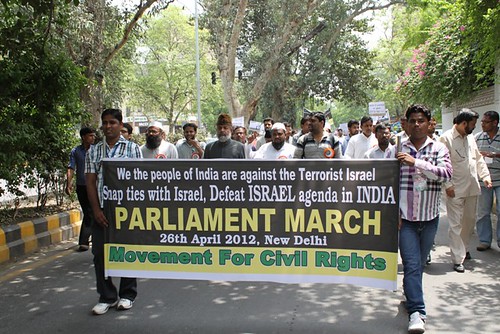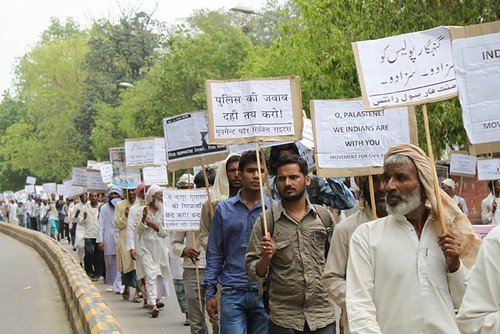COMMENTS
POSTED ON THE TIMES OF INDIA Q&A INTERVIEW OF MS. FLAVIA AGNES BY
JYOTI PUNWANI: Women's rights would fall into place with secure economic
rights:
Feminist lawyer Flavia Agnes 's organisation Majlis has helped draft Maharashtra's new matrimonial property Bill, giving women
an equal share in matrimonial property. However, some traditional
community leaders want Muslim women kept out of the purview of this
Bill. Speaking with Jyoti Punwani , Agnes explains why a law like this
would not override existing Muslim personal law provisions safeguarding women in marital distress - and how crucial economic security is to the well-being of all women:
How did you get involved with drafting this law?
When reports about the Maharashtra government proposing a matrimonial property Bill first appeared, Majlis met the concerned minister who invited us to draft a Billa¦it's my firm belief that all women's rights would fall into place if we're able to secure their economic rights. This is crucial to protect women from destitution - what can maintenance of Rs 500 do for you and your children? Therefore, after consultations with bureaucrats, lawyers, judges and activists, we came up with this draft.
Did you anticipate a negative reaction?
I anticipated a backlash from men's rights groups but not from Muslim leaders - this is because whatever progress matrimonial law has made in India has brought it closer to Islamic law. Every modern concept of marriage already exists in Islamic law - be it viewing marriage as a contract between equals with prenuptial agreements, giving the wife a share in property and economic security, acknowledging that marriage may not be lifelong, providing for arbitration and if that fails, for a quick and easy dissolution through divorce by consent, with a fair and reasonable settlement.
All this evolved at a time when other religions were very oppressive towards women. In the 7th century, the Prophet Muhammad held the view that wives aren't slaves - they have an independent identity and need economic security. How can it ever be construed that a Prophet so compassionate towards women would deny their rights to matrimonial property? In fact, the Muslim Women's Act (MWA) of 1986 has already incorporated this principle.
But will you be able to convince traditional community leaders of this today?
Muslim leaders do know about our earlier work with the communitya¦and today, the ulema or clergy are not saying that Muslim women have no rights - their claim is that Muslim women already have a right in sharia. This can be acknowledged and provided for in the new law where a section states that if a woman has a similar right under her personal law, she can avail of it. Muslim women must persuade the Personal Law Board to set up the machinery that will give women this Islamic right.
Is there a possibility of history being repeated - with echoes of the Shah Bano case - if leaders can ultimately prevail on the government to exclude Muslim women from this law?
Shah Bano's case resulted in the MWA. The Supreme Court upheld its validity in 2002. The MWA has actually given far more in lump sum settlements to divorced Muslim women than any secular law. The media highlights only negative instances, such as Imrana and Gudiya, but not the victories of Muslim women under their personal law. If Muslim women are excluded from this new law, they'd still have the right to ask for a settlement under MWA - and the exclusion could also be challenged
Though the very seasoned women's right activist Ms. Flavia
Agnes's words in this interview may be welcome when she candidly admits that
"Every modern concept of marriage already exists in Islamic law - be it
viewing marriage as a contract between equals with prenuptial agreements,
giving the wife a share in property and economic security, acknowledging that
marriage may not be lifelong, providing for arbitration and if that fails, for
a quick and easy dissolution through divorce by consent, with a fair and reasonable
settlement. All this evolved at a time when other religions were very
oppressive towards women. In the 7th century, the Prophet Muhammad held the
view that wives aren't slaves - they have an independent identity and need
economic security. How can it ever be construed that a Prophet so compassionate
towards women would deny their rights to matrimonial property? In fact, the
Muslim Women's Act (MWA) of 1986 has already incorporated this principle."
However, she ignores TWO main factors that should be
considered before reformists try to improve on Sharia. In India, the enactment
of Muslim Personal Law, back in British rule in 1937, was meant to keep sharia
intact against the incursions by governments through arbitrary fiats. That main
objective of Muslim Personal Law should not only be kept in mind when Muslim
affairs are in question; but the caution should be extended as to why a secular
state and government should be interfering in the personal laws of different
religion, be that Brahmin, Sikh, Jain, Parsi etc. British justice was colonial
justice. India's secular constitution should stick more strictly to its
secularism and leave the religious matters best to be sorted out by various
religious communities. Why should Nehru have meddled in Hindu personal laws
when he was publicly declaring that India is not a Hindu nation, but a
secular republic.
India's women's rights movement is heavily influenced by
Western ideas that need not always be relevant in Secular India with very high
public commitment to religious tradition.
The second point that Ms. Agnes should have taken into
consideration when it comes to Muslims and Islam, that Sharia has a holistic
view of the family as a basic unit. We cannot think of apportioning properties
among Muslim members of families without taking into consideration the very
strict inheritance laws. Any effort to preempt those ratios will be null and
void. It would have been better if Ms. Flavia should have first cleared her
legislative initiative with Muslim Personal Law Board, who effectively represents
the 180 million Muslims of India, at least intellectually. She is as guilty of
ignoring Muslim Personal Law Board, as the English media, among others, in Mumbai
that did not care to cover the huge gathering of about 200,000 Muslim
protestors at Azad maidan, possibly at the behest of the ruling Congress party.
Ghulam Muhammed, Mumbai
---------------
'Women's rights would fall into place with secure economic rights'
Apr 30, 2012, 12.00AM ISTHow did you get involved with drafting this law?
When reports about the Maharashtra government proposing a matrimonial property Bill first appeared, Majlis met the concerned minister who invited us to draft a Billa¦it's my firm belief that all women's rights would fall into place if we're able to secure their economic rights. This is crucial to protect women from destitution - what can maintenance of Rs 500 do for you and your children? Therefore, after consultations with bureaucrats, lawyers, judges and activists, we came up with this draft.
Did you anticipate a negative reaction?
I anticipated a backlash from men's rights groups but not from Muslim leaders - this is because whatever progress matrimonial law has made in India has brought it closer to Islamic law. Every modern concept of marriage already exists in Islamic law - be it viewing marriage as a contract between equals with prenuptial agreements, giving the wife a share in property and economic security, acknowledging that marriage may not be lifelong, providing for arbitration and if that fails, for a quick and easy dissolution through divorce by consent, with a fair and reasonable settlement.
All this evolved at a time when other religions were very oppressive towards women. In the 7th century, the Prophet Muhammad held the view that wives aren't slaves - they have an independent identity and need economic security. How can it ever be construed that a Prophet so compassionate towards women would deny their rights to matrimonial property? In fact, the Muslim Women's Act (MWA) of 1986 has already incorporated this principle.
But will you be able to convince traditional community leaders of this today?
Muslim leaders do know about our earlier work with the communitya¦and today, the ulema or clergy are not saying that Muslim women have no rights - their claim is that Muslim women already have a right in sharia. This can be acknowledged and provided for in the new law where a section states that if a woman has a similar right under her personal law, she can avail of it. Muslim women must persuade the Personal Law Board to set up the machinery that will give women this Islamic right.
Is there a possibility of history being repeated - with echoes of the Shah Bano case - if leaders can ultimately prevail on the government to exclude Muslim women from this law?
Shah Bano's case resulted in the MWA. The Supreme Court upheld its validity in 2002. The MWA has actually given far more in lump sum settlements to divorced Muslim women than any secular law. The media highlights only negative instances, such as Imrana and Gudiya, but not the victories of Muslim women under their personal law. If Muslim women are excluded from this new law, they'd still have the right to ask for a settlement under MWA - and the exclusion could also be challenged






